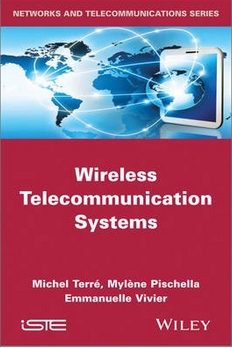
Wireless Telecommunication Systems
[BOOK DESCRIPTION]
Wireless telecommunication systems generate a huge amount of interest. In the last two decades, these systems have experienced at least three major technological leaps, and it has become impossible to imagine how society was organized without them. In this book, we propose a macroscopic approach on wireless systems, and aim at answering key questions about power, data rates, multiple access, cellular engineering and access networks architectures. We present a series of solved problems, whose objective is to establish the main elements of a global link budget in several radiocommunications systems. Contents 1. Radio Propagation. 2. F/TDMA and GSM. 3. CDMA and UMTS. 4. OFDM and LTE. 5. MIMO and Beamforming. 6. UWB. 7. Synchronization. 8. Digital Communications Fundamentals. 9. Erlang B Tables. About the Authors Michel Terre received his engineering degree from Telecom SudParis, his phD in electronics and telecommunications from Conservatoire National des Arts et Metiers (CNAM), and his habilitation to conduct researches from Paris XIII University. He is a full professor at Conservatoire National des Arts et Metiers.He his responsabile of CNAM's Master of Science in radiocommunicationssystems. Mylene Pischella received her engineering degree and her phD in electronics and telecommunications from Telecom ParisTech. She is an associate professor at Conservatoire National des Arts et Metiers (CNAM). Emmanuelle Vivier received her engineering degree from Institut Superieur d'Electronique de Paris (ISEP) and her PhD in radiocommunications from Conservatoire National des Arts et Metiers (CNAM). She is an associate professor at ISEP, where she is responsible of networks and telecommunications teaching majors.
[TABLE OF CONTENTS]
Foreword ix
Preface xi
Chapter 1 Radio Propagation 1 (22)
1.1 Free-space loss link budget and 2 (5)
capacity
1.2 Link budget and free-space loss 7 (2)
1.3 Linear expression of the Okumura-Hata 9 (2)
model
1.4 Frequency, distance and propagation 11 (2)
model
1.5 Link budget and diffraction 13 (2)
1.6 Link budget and refraction 15 (3)
1.7 Link budget and diffusion 18 (2)
1.8 Frequency and time selectivity 20 (1)
1.9 Doppler effect 21 (2)
Chapter 2 F/TDMA and GSM 23 (36)
2.1 Maximum transmitter-receiver distance 24 (2)
2.2 Extended maximum transmitter-receiver 26 (1)
distance
2.3 Reuse distance, interference 26 (6)
reduction factor K and regular pattern
2.4 Radio resources dimensioning in GSM 32 (1)
2.5 Link budget in an isolated GSM cell 33 (3)
2.6 Deployment of a GSM network along a 36 (5)
highway
2.7 GSM network dimensioning and planning 41 (3)
in a rural area
2.8 GSM network dimensioning and planning 44 (2)
in an urban area
2.9 SMS transmission in a GSM network 46 (2)
2.10 Frequency reuse pattern determination 48 (2)
2.11 Traffic and Erlang for GSM cell 50 (2)
dimensioning
2.12 Signal to noise plus interference 52 (7)
ratio
Chapter 3 CDMA and UMTS 59 (36)
3.1 Spreading and CDMA 63 (1)
3.2 Hadamard spreading codes: a perfect 64 (5)
orthogonality between the users?
3.3 Relation between Eb / N0 and the 69 (1)
reception threshold in UMTS networks
3.4 Required number of codes in CDMA 70 (1)
3.5 UMTS link budget 71 (6)
3.6 Cell breathing in UMTS networks 77 (3)
3.7 Intersite distance calculation in 80 (3)
UMTS networks for different frequency
reuse patterns
3.8 Case study in UMTS networks 83 (12)
Chapter 4 OFDM and LTE 95 (34)
4.1 Useful throughput of an OFDM waveform 96 (4)
4.2 OFDM and PAPR 100(4)
4.3 Frequency selectivity and OFDM 104(2)
dimensioning
4.4 OFDM dimensioning 106(1)
4.5 OFDM dimensioning for 4G networks and 107(3)
data rate evaluations
4.6 LTE data rates evaluation 110(3)
4.7 LTE link budget 113(7)
4.8 LTE link budget taking into account 120(3)
the number of users
4.9 Modulation-coding scheme relation, 123(6)
spectral efficiency and SINR in LTE
networks
Chapter 5 MIMO and Beamforming 129(26)
5.1 Beamforming and signal-to-noise ratio 133(7)
5.2 Space diversity and chi-square 140(9)
distribution
5.3 MIMO and capacity 149(6)
Chapter 6 UWB 155(12)
6.1 Impulse UWB 157(4)
6.2 UWB and OFDM 161(2)
6.3 Link budget for UWB transmission 163(4)
Chapter 7 Synchronization 167(12)
7.1 Cramer-Rao bound 168(2)
7.2 Modified Cramer-Rao bound 170(1)
7.3 Constant parameter estimation 170(4)
7.4 Radio burst synchronization 174(2)
7.5 Phase estimation for QPSK modulation 176(3)
Chapter 8 Digital Communications 179(26)
Fundamentals
8.1 Review of signal processing for 179(1)
signal-to-noise ratio
8.2 Review of digital modulations 179(1)
8.3 Review of equalization 180(1)
8.4 Signal-to-noise ratio estimation 181(3)
8.5 ASK 2 modulation error probability 184(3)
8.6 Spectral occupancy, symbol rate and 187(2)
binary throughput
8.7 Comparison of two linear digital 189(2)
modulations
8.8 Comparison of two-PSK modulation and 191(3)
power evaluations
8.9 Zero-forcing linear equalization 194(2)
8.10 Minimum mean square error linear 196(4)
equalization
8.11 Noise factor in equipments 200(3)
8.12 Data rate calculations 203(2)
Chapter 9 Erlang B Tables 205(4)
Bibliography 209(2)
Index 211

 新书报道
新书报道